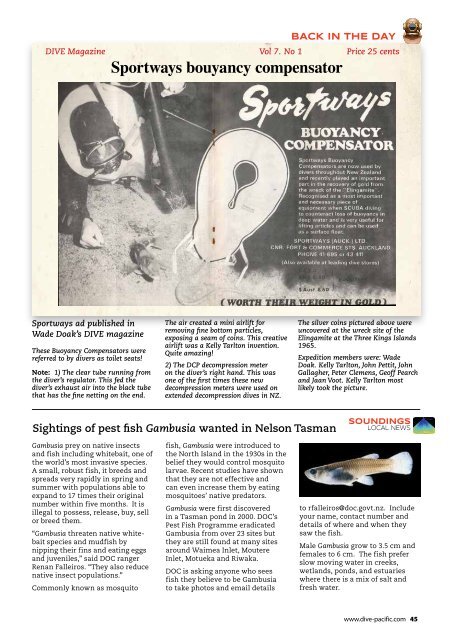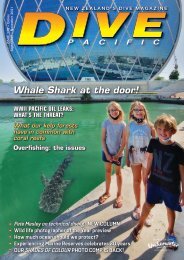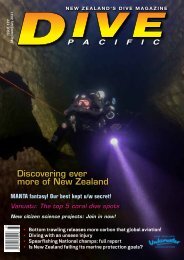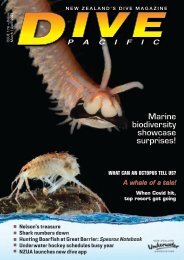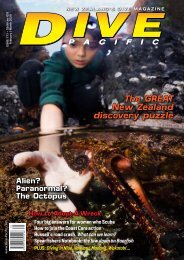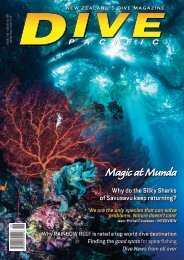Dive Pacific Iss 171 Oct- Nov 2019
New Zealand's dive magazine featuring in this issue: Shooting big sharks, up close; Spearfishing at night!; Remembering a great Kiwi dive pioneer, Wade Doak; Forgotten Vanuatu wreck's claim to fame; The invasive Lionfish - in depth, plus all our expert columnists
New Zealand's dive magazine featuring in this issue: Shooting big sharks, up close; Spearfishing at night!; Remembering a great Kiwi dive pioneer, Wade Doak; Forgotten Vanuatu wreck's claim to fame; The invasive Lionfish - in depth, plus all our expert columnists
Create successful ePaper yourself
Turn your PDF publications into a flip-book with our unique Google optimized e-Paper software.
BACK IN THE DAY<br />
DIVE Magazine Vol 7. No 1 Price 25 cents<br />
Sportways bouyancy compensator<br />
Sportways ad published in<br />
Wade Doak’s DIVE magazine<br />
These Buoyancy Compensators were<br />
referred to by divers as toilet seats!<br />
Note: 1) The clear tube running from<br />
the diver’s regulator. This fed the<br />
diver’s exhaust air into the black tube<br />
that has the fine netting on the end.<br />
The air created a mini airlift for<br />
removing fine bottom particles,<br />
exposing a seam of coins. This creative<br />
airlift was a Kelly Tarlton invention.<br />
Quite amazing!<br />
2) The DCP decompression meter<br />
on the diver’s right hand. This was<br />
one of the first times these new<br />
decompression meters were used on<br />
extended decompression dives in NZ.<br />
The silver coins pictured above were<br />
uncovered at the wreck site of the<br />
Elingamite at the Three Kings Islands<br />
1965.<br />
Expedition members were: Wade<br />
Doak. Kelly Tarlton, John Pettit, John<br />
Gallagher, Peter Clemens, Geoff Pearch<br />
and Jaan Voot. Kelly Tarlton most<br />
likely took the picture.<br />
Sightings of pest fish Gambusia wanted in Nelson Tasman<br />
SOUNDINGS<br />
LOCAL NEWS<br />
Gambusia prey on native insects<br />
and fish including whitebait, one of<br />
the world’s most invasive species.<br />
A small, robust fish, it breeds and<br />
spreads very rapidly in spring and<br />
summer with populations able to<br />
expand to 17 times their original<br />
number within five months. It is<br />
illegal to possess, release, buy, sell<br />
or breed them.<br />
“Gambusia threaten native whitebait<br />
species and mudfish by<br />
nipping their fins and eating eggs<br />
and juveniles,” said DOC ranger<br />
Renan Falleiros. “They also reduce<br />
native insect populations.”<br />
Commonly known as mosquito<br />
fish, Gambusia were introduced to<br />
the North Island in the 1930s in the<br />
belief they would control mosquito<br />
larvae. Recent studies have shown<br />
that they are not effective and<br />
can even increase them by eating<br />
mosquitoes’ native predators.<br />
Gambusia were first discovered<br />
in a Tasman pond in 2000. DOC’s<br />
Pest Fish Programme eradicated<br />
Gambusia from over 23 sites but<br />
they are still found at many sites<br />
around Waimea Inlet, Moutere<br />
Inlet, Motueka and Riwaka.<br />
DOC is asking anyone who sees<br />
fish they believe to be Gambusia<br />
to take photos and email details<br />
to rfalleiros@doc.govt.nz. Include<br />
your name, contact number and<br />
details of where and when they<br />
saw the fish.<br />
Male Gambusia grow to 3.5 cm and<br />
females to 6 cm. The fish prefer<br />
slow moving water in creeks,<br />
wetlands, ponds, and estuaries<br />
where there is a mix of salt and<br />
fresh water.<br />
www.dive-pacific.com 45


